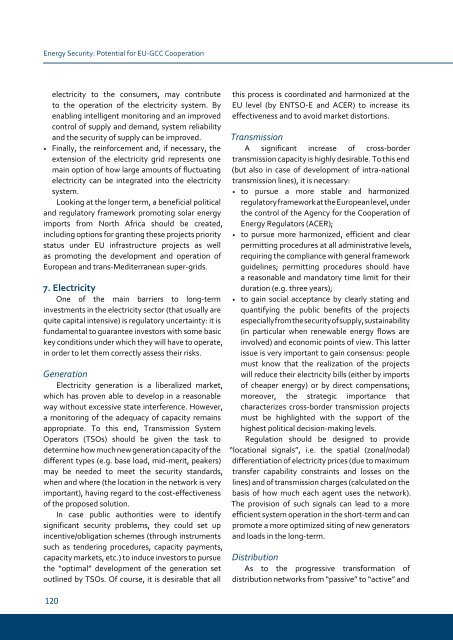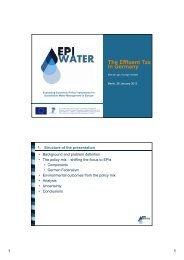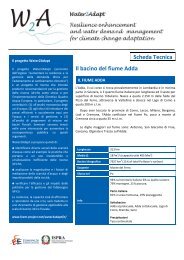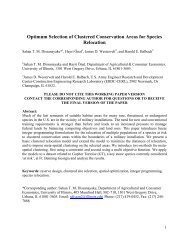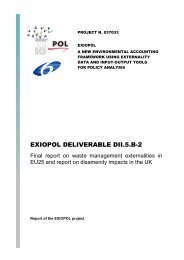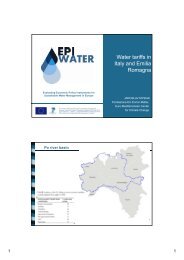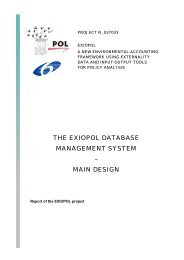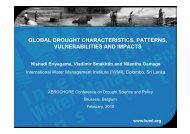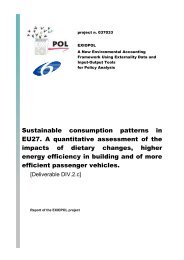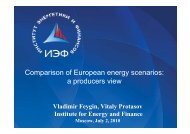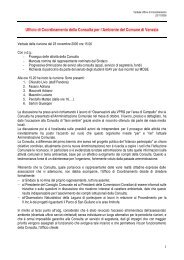Gulf and European Energy Supply Security - Feem-project.net
Gulf and European Energy Supply Security - Feem-project.net
Gulf and European Energy Supply Security - Feem-project.net
Create successful ePaper yourself
Turn your PDF publications into a flip-book with our unique Google optimized e-Paper software.
<strong>Energy</strong> <strong>Security</strong>: Potential for EU-GCC Cooperation<br />
electricity to the consumers, may contribute<br />
to the operation of the electricity system. By<br />
enabling intelligent monitoring <strong>and</strong> an improved<br />
control of supply <strong>and</strong> dem<strong>and</strong>, system reliability<br />
<strong>and</strong> the security of supply can be improved.<br />
• Finally, the reinforcement <strong>and</strong>, if necessary, the<br />
extension of the electricity grid represents one<br />
main option of how large amounts of fluctuating<br />
electricity can be integrated into the electricity<br />
system.<br />
Looking at the longer term, a beneficial political<br />
<strong>and</strong> regulatory framework promoting solar energy<br />
imports from North Africa should be created,<br />
including options for granting these <strong>project</strong>s priority<br />
status under EU infrastructure <strong>project</strong>s as well<br />
as promoting the development <strong>and</strong> operation of<br />
<strong>European</strong> <strong>and</strong> trans-Mediterranean super-grids.<br />
7. electricity<br />
One of the main barriers to long-term<br />
investments in the electricity sector (that usually are<br />
quite capital intensive) is regulatory uncertainty: it is<br />
fundamental to guarantee investors with some basic<br />
key conditions under which they will have to operate,<br />
in order to let them correctly assess their risks.<br />
Generation<br />
Electricity generation is a liberalized market,<br />
which has proven able to develop in a reasonable<br />
way without excessive state interference. However,<br />
a monitoring of the adequacy of capacity remains<br />
appropriate. To this end, Transmission System<br />
Operators (TSOs) should be given the task to<br />
determine how much new generation capacity of the<br />
different types (e.g. base load, mid-merit, peakers)<br />
may be needed to meet the security st<strong>and</strong>ards,<br />
when <strong>and</strong> where (the location in the <strong>net</strong>work is very<br />
important), having regard to the cost-effectiveness<br />
of the proposed solution.<br />
In case public authorities were to identify<br />
significant security problems, they could set up<br />
incentive/obligation schemes (through instruments<br />
such as tendering procedures, capacity payments,<br />
capacity markets, etc.) to induce investors to pursue<br />
the “optimal” development of the generation set<br />
outlined by TSOs. Of course, it is desirable that all<br />
120<br />
this process is coordinated <strong>and</strong> harmonized at the<br />
EU level (by ENTSO-E <strong>and</strong> ACER) to increase its<br />
effectiveness <strong>and</strong> to avoid market distortions.<br />
Transmission<br />
A significant increase of cross-border<br />
transmission capacity is highly desirable. To this end<br />
(but also in case of development of intra-national<br />
transmission lines), it is necessary:<br />
• to pursue a more stable <strong>and</strong> harmonized<br />
regulatory framework at the <strong>European</strong> level, under<br />
the control of the Agency for the Cooperation of<br />
<strong>Energy</strong> Regulators (ACER);<br />
• to pursue more harmonized, efficient <strong>and</strong> clear<br />
permitting procedures at all administrative levels,<br />
requiring the compliance with general framework<br />
guidelines; permitting procedures should have<br />
a reasonable <strong>and</strong> m<strong>and</strong>atory time limit for their<br />
duration (e.g. three years);<br />
•<br />
to gain social acceptance by clearly stating <strong>and</strong><br />
quantifying the public benefits of the <strong>project</strong>s<br />
especially from the security of supply, sustainability<br />
(in particular when renewable energy flows are<br />
involved) <strong>and</strong> economic points of view. This latter<br />
issue is very important to gain consensus: people<br />
must know that the realization of the <strong>project</strong>s<br />
will reduce their electricity bills (either by imports<br />
of cheaper energy) or by direct compensations;<br />
moreover, the strategic importance that<br />
characterizes cross-border transmission <strong>project</strong>s<br />
must be highlighted with the support of the<br />
highest political decision-making levels.<br />
Regulation should be designed to provide<br />
“locational signals”, i.e. the spatial (zonal/nodal)<br />
differentiation of electricity prices (due to maximum<br />
transfer capability constraints <strong>and</strong> losses on the<br />
lines) <strong>and</strong> of transmission charges (calculated on the<br />
basis of how much each agent uses the <strong>net</strong>work).<br />
The provision of such signals can lead to a more<br />
efficient system operation in the short-term <strong>and</strong> can<br />
promote a more optimized siting of new generators<br />
<strong>and</strong> loads in the long-term.<br />
Distribution<br />
As to the progressive transformation of<br />
distribution <strong>net</strong>works from “passive” to “active” <strong>and</strong>


